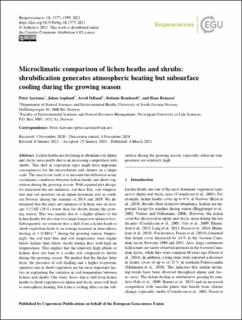| dc.description.abstract | Lichen heaths are declining in abundance in alpine and Arctic areas partly due to an increasing competition with shrubs. This shift in vegetation types might have important consequences for the microclimate and climate on a larger scale. The aim of our study is to measure the difference in microclimatic conditions between lichen heaths and shrub vegetation during the growing season. With a paired plot design, we measured the net radiation, soil heat flux, soil temperature and soil moisture on an alpine mountain area in southern Norway during the summer of 2018 and 2019. We determined that the daily net radiation of lichens was on average 3.15 MJ (26 %) lower than for shrubs during the growing season. This was mainly due to a higher albedo of the lichen heaths but also due to a larger longwave radiation loss. Subsequently, we estimate that a shift from a lichen heath to shrub vegetation leads to an average increase in atmospheric heating of 3.35 MJ d−1 during the growing season. Surprisingly, the soil heat flux and soil temperature were higher below lichens than below shrubs during days with high air temperatures. This implies that the relatively high albedo of lichens does not lead to a cooler soil compared to shrubs during the growing season. We predict that the thicker litter layer, the presence of soil shading and a higher evapotranspiration rate at shrub vegetation are far more important factors in explaining the variation in soil temperature between lichens and shrubs. Our study shows that a shift from lichen heaths to shrub vegetation in alpine and Arctic areas will lead to atmospheric heating, but it has a cooling effect on the subsurface during the growing season, especially when air temperatures are relatively high. | |
